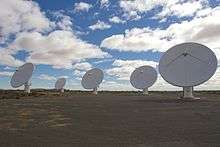KAT-7
 Five antennas of KAT-7 in 2014 | |
| Location(s) |
Northern Cape, South Africa |
|---|---|
| Coordinates | 30°43′16″S 21°24′40″E / 30.721°S 21.411°ECoordinates: 30°43′16″S 21°24′40″E / 30.721°S 21.411°E |
| Organization |
Department of Science and Technology National Research Foundation of South Africa |
| Altitude | 1,100 m (3,600 ft) |
| Wavelength | 3 cm (10.0 GHz)-30 cm (1,000 MHz) |
| Built | –2011 |
| First light |
2009 |
| Telescope style |
radio interferometer |
| Number of telescopes | 7 |
| Diameter | 12 m (39 ft 4 in) |
| Collecting area | 2,000 m2 (22,000 sq ft) |
| Website |
www |
 Location of KAT-7 | |
KAT-7 is a radio telescope constructed in the Northern Cape of South Africa. Part of the Karoo Array Telescope project, it is the precursor engineering test bed to the larger MeerKAT telescope, but it has become a science instrument in its own right. The construction was completed in 2011 and commissioned in 2012. It also served as a technology demonstrator for South Africa's bid to host the Square Kilometre Array.[1] KAT-7 is the first Radio telescope to be built with a composite reflector and uses a stirling pump for 75 K cryogenic cooling. The telescope was built to test various system for the MeerKAT array, from the ROACH correlators designed and manufactured in Cape Town, now used by various telescopes internationally, to composite construction techniques.[2] With the short baselines the telescope is suited to observing diffuse sources, but will begin VLBI observation in 2013.
Technical Specifications
KAT-7 consist of 7 dishes of 12 metres in diameter each a Prime Focus Reflecting telescope.[3]
MeerKAT supports a wide range of observing modes, including deep continuum, polarisation and spectral line imaging, pulsar timing and transient searches. A range of standard data products are provided, including an imaging pipeline. A number of "data spigots" are also available to support user-provided instrumentation. Significant design and qualification efforts are planned to ensure high reliability in order to achieve low operational cost and high availability.
| Parameter | Value |
| Number of antennae | 7 |
| Dish diameter | 12 m |
| Minimum baseline | 26 m |
| Maximum baseline | 185 m |
| Frequency Range | 1200 MHz - 1950 MHz |
| Instantaneous Bandwidth | 256 MHz |
| Polarisation | Linear (H + V) |
| Tsys | < 35 K across the entire frequency band (~30 K average)for all elevation angles > 30 deg |
| Elevation | 2 - 95 degrees |
| Mode | # Bands | Band Bandwidth | Channel Bandwidth | Available |
| Wideband | 1 | 256 MHz | 390.625 kHz | Yes |
| 8k Wideband | 1 | 256 MHz | 48.8 kHz | Yes |
| HI Spectral Line | 1 | >= 33.4 MHz | <= 4.8 kHz | ~ Oct 2012 |
| OH Spectral Line | 1 | 400/32 = 12.5 MHz | 1.5 kHz | ~ Jun 2012 |
| OH Spectral Line | 1 | 400/128 = 3.1 MHz | 381 Hz | ~ Jun 2012 |
Performance
In April 2010 four of the seven dishes were linked together as an integrated system to produce its first interferometric image of an astronomical object. In Dec 2010, there was a successful detection of very long baseline interferometry (VLBI) fringes between the Hartebeesthoek Radio Astronomy Observatory's 26 m dish and one of the KAT-7 dishes.[4]
See also
- Australian Square Kilometre Array Pathfinder
- Hartebeesthoek Radio Astronomy Observatory
- List of radio telescopes
- South African Astronomical Observatory for optical astronomy in South Africa
- Precision Array for Probing the Epoch of Reionization
References
|
|
- ↑ Campbell, Keith (2009-04-03). "An array of technology spin-offs emerges as the ‘MeerKAT’ radio telescope gains traction". Martin Creamer Engineering News. Retrieved 2009-06-30.
- ↑ "International Correlator Collaboration |". Retrieved 2012-05-11.
- ↑ "KAT-7". SKA South Africa Project. Retrieved 20 January 2012.
- ↑ First HartRAO-KAT-7 VLBI fringes signal new capability
External links
| Wikimedia Commons has media related to KAT-7. |